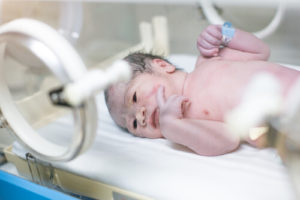Conditions Caused by Delivery Room Errors

The delivery room is the place where your child enters the world. Unfortunately, delivery room errors can result in life-altering conditions that can change your family’s priorities in an instant.
As a birth injury practice for over 30 years, Stern Law, PLLC has focused on helping moms and dads like you fight for the compensation you deserve to support the needs of your special child. Please call (800) 462-5772 to learn more about protecting your family’s rights.
What Types of Birth Injury Are Caused by Delivery Room Error?
There are many birth injuries that can result from mistakes by medical personnel in the delivery room. Some of the more common and heartbreaking injuries include:
- Cephalopelvic Disproportion – This condition may result from a vacuum assisted delivery resulting in a collection of blood between the skull and the periosteum. This may increase the risk of jaundice.
- Caput Succedaneum – This refers to swelling of the soft tissues on a baby’s head and scalp and is caused by pressure exerted on a baby’s head during delivery. When a child has shoulder dystocia, doctors may decide to use certain obstetric instruments such as forceps and vacuum extractors to facilitate an obstructed vaginal delivery. However, these instruments can result in the aforementioned condition.
- Subgaleal Hematoma – This refers to swelling that occurs between a baby’s skull bones and scalp caused by pressure asserted on his or her head during delivery. Swelling may extend around the baby’s eyes, ears and may also, depending upon the severity of the case, completely cover the baby’s head. As mentioned above, the use of obstetric instruments during delivery may increase a child’s chance of sustaining this type of traumatic birth injury.
- Cephalhematoma – This refers to hemorrhaging that occurs between a baby’s skull and periosteum (a membrane that lines the surface of all bones in the body except at the joints). In some cases, this condition may occur secondarily to skull fractures and typically arises when pressure is asserted on a baby’s head during delivery, perhaps through the use of forceps or vacuum extraction.
- Sternocleidomastoid Hematoma – This traumatic birth injury occurs when a baby’s head is twisted to one side during delivery, which leads to tightness in and the potential shortening of the sternocleidomastoid muscles (the muscles that are present between a baby’s breastbone and collarbone that connects them to the portion of the skull behind his or her ear). If left untreated, or in the most severe of birth injury cases, a child may be left with limited to no movement in his or her neck and also suffer from craniofacial abnormalities.
- Intracranial Hemorrhage -This hemorrhage occurs to a baby’s brain as a result of pressure asserted on his or her head during delivery. While there may not be any physically visible symptoms of this condition, children will exhibit signs of labored breathing, seizures and sluggishness. As mentioned above, the use of obstetric instruments during delivery – sometimes necessary to facilitate a difficult delivery of a child – may increase a child’s chance of sustaining this type of traumatic injury.
- Subaponeurotic Hemorrhage – Although generally rare, this condition occurs when pressure is asserted on the head in such a way as to cause blood vessels to break and cause bleeding in the aponeurosis of the skull (a layer of flat, connective tissue that anchors a muscle to the various parts that it moves). As mentioned above, the use of obstetric instruments during delivery may increase a child’s chance of sustaining this type of injury.
- Cerebral Palsy – Also called CP, this condition manifests as a result of injuries sustained to a child’s brain before, during or after birth. Specifically, CP affects a child’s body movement, muscle control, muscle coordination, muscle tone, reflex, posture and balance. It can also impact one’s fine motor skills, gross motor skills and oral motor functioning. For more information, you can also click here to learn everything you need to know about the causes of, treatments for, and prevention of cerebral palsy.
- Hypoxic-Ischemic Encephalopathy – This is a condition where an unborn child’s brain does not receive enough oxygen and blood. If a child becomes lodged in the birth canal, he or she may develop this complication, leading to a multitude of different traumatic birth injuries.
- Periventricular Leukomalacia – This type of brain injury involves the death, or necrosis, to the white matter of the brain. This is caused by a lack of oxygen or blood flow to the periventricular area around the parts of the brain called ventricles (nerve fibers that transmit messages from the brain to the muscles of the body). As with the above, if a child becomes lodged in the birth canal, he or she may develop this complication.
- Developmental Delay – Several forms of traumatic birth injuries can cause delays in a child’s motor, physical and mental development, leading to a lifetime of difficulties.
- Brachial Plexus Injuries – These injuries are sustained to the network of nerves that control movement in the neck, shoulders, arms and hands. Injuries range from minor muscle tear to the severing of a nerve root to the spinal cord. In general, these types of injuries are categorized into two types, which depend upon the location of the injury sustained. Upper brachial plexus injures affect the shoulders and elbows, while lower plexus injuries affect the muscles in the hand and forearms.
- Erb’s Palsy – This is a primary example of an upper brachial plexus injury that results in the weakness and loss of movement in a baby’s arms and shoulders.
- Klumpke’s Palsy – This form of a lower brachial plexus injury causes lesions in the lower brachial nerves. When a child is affected by this condition, typically they have limited to no movement in the forearms and hands.
- Seizure Disorders – Certain types of traumatic birth trauma can undoubtedly cause seizures as well as seizure disorders in a newborn. Specifically, if a child is lodged in the birth canal, his or her oxygen supply may be compromised. As a result, certain seizure disorders may arise due to the lack of oxygen and other complications associated therewith.
- Paralysis – Lack of fetal oxygen and excessive force used during delivery are some of the ways in which a fetus can be traumatically injured, such as being partially or fully paralyzed at birth.
- Mental Retardation – Sustained periods of little to no oxygen is one of the primary ways in which an otherwise healthy fetus can become mentally retarded at birth.
We must do more for children and families affected by birth injuries caused by medical malpractice and delivery room errors. With this in mind, our firm works tirelessly to not only handle our clients’ lawsuits, but also to provide them access to government and insurance benefits, cutting edge medical treatments and therapies, and special education to meet the needs of their special child. This is the Stern Law, PLLC difference.
If you wish to learn more about your legal options, our firm is ready now to assist you and your child in any way we possibly can. Please call (800) 462-5772 for a free consultation.







